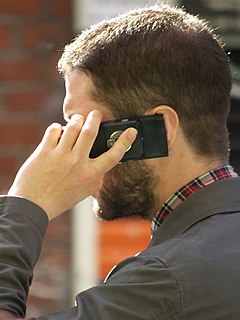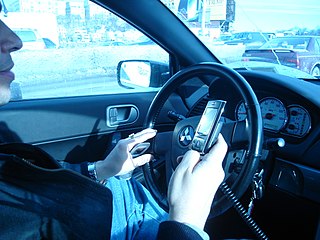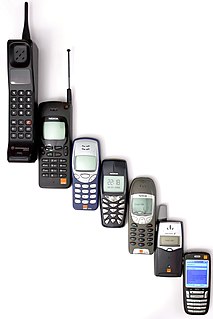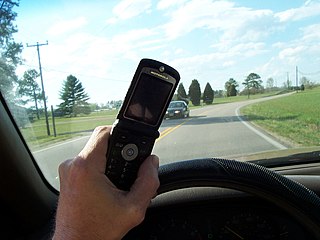
Smartphones are a class of mobile phones and of multi-purpose mobile computing devices. They are distinguished from feature phones by their stronger hardware capabilities and extensive mobile operating systems, which facilitate wider software, internet, and multimedia functionality, alongside core phone functions such as voice calls and text messaging. Smartphones typically include various sensors that can be leveraged by their software, such as a magnetometer, proximity sensors, barometer, gyroscope and accelerometer, and support wireless communications protocols such as Bluetooth, Wi-Fi, and satellite navigation.

In Japan, mobile phones have become ubiquitous. In Japanese, mobile phones are called keitai denwa (携帯電話), literally "portable telephones," and are often known simply as keitai.

A cell site, cell tower, or cellular base station is a cellular-enabled mobile device site where antennae and electronic communications equipment are placed — typically on a radio mast, tower, or other raised structure — to create a cell in a cellular network. The raised structure typically supports antennae and one or more sets of transmitter/receivers transceivers, digital signal processors, control electronics, a GPS receiver for timing, primary and backup electrical power sources, and sheltering.

Mobile computing is human–computer interaction by which a computer is expected to be transported during normal usage, which allows for transmission of data, voice and video. Mobile computing involves mobile communication, mobile hardware, and mobile software. Communication issues include ad hoc networks and infrastructure networks as well as communication properties, protocols, data formats and concrete technologies. Hardware includes mobile devices or device components. Mobile software deals with the characteristics and requirements of mobile applications.

Mobile telephony is the provision of telephone services to phones which may move around freely rather than stay fixed in one location. Mobile phones connect to a terrestrial cellular network of base stations, whereas satellite phones connect to orbiting satellites. Both networks are interconnected to the public switched telephone network (PSTN) to allow any phone in the world to be dialed.

The history of mobile phones covers mobile communication devices that connect wirelessly to the public switched telephone network.

The effect of mobile phone radiation on human health is a subject of interest and study worldwide, as a result of the enormous increase in mobile phone usage throughout the world. As of 2015, there were 7.4 billion subscriptions worldwide, though the actual number of users is lower as many users own more than one mobile phone. Mobile phones use electromagnetic radiation in the microwave range. Other digital wireless systems, Such as data communication networks, produce similar radiation.
In the U.S., Federal Communications Commission (FCC) regulations prohibit the use of mobile phones aboard aircraft in flight. Contrary to popular misconception, the Federal Aviation Administration (FAA) does not actually prohibit the use of personal electronic devices on aircraft. Paragraph (b)(5) of 14 CFR 91.21 leaves it up to the airlines to determine if devices can be used in flight, allowing use of "Any other portable electronic device that the operator of the aircraft has determined will not cause interference with the navigation or communication system of the aircraft on which it is to be used."

Mobile phone tracking is a process for identifying the location of a mobile phone, whether stationary or moving. Localization may occur either via multilateration of radio signals between (several) cell towers of the network and the phone, or simply via GPS. To locate a mobile phone using multilateration of radio signals, it must emit at least the roaming signal to contact the next nearby antenna tower, but the process does not require an active call. The Global System for Mobile Communications (GSM) is based on the phone's signal strength to nearby antenna masts.

Mobile phone use while driving is common, but it is widely considered dangerous due to its potential for causing distracted driving and crashes. Due to the number of crashes that are related to conducting calls on a phone and texting while driving, some jurisdictions have made the use of calling on a phone while driving illegal. Many jurisdictions have enacted laws to ban handheld mobile phone use. Nevertheless, many jurisdictions allow use of a hands-free device. Driving while using a hands-free device is not safer than using a handheld phone to conduct calls, as concluded by case-crossover studies, epidemiological, simulation, and meta-analysis. In some cases restrictions are directed only at minors, those who are newly qualified license holders, or to drivers in school zones. In addition to voice calling, activities such as texting while driving, web browsing, playing video games, or phone use in general can also increase the risk of a crash.
Mobility and portability of media, or as Paul Levinson calls it in his book Cellphone, “the media-in-motion business” has been a process in the works ever since the “first time someone thought to write on a tablet that could be lifted and hauled – rather than on a cave wall, a cliff face, a monument that usually was stuck in place, more or less forever”. For a time, mobile media devices such as mobile phones and PDA’s were the primary source of portable media from which we could obtain information and communicate with one another. More recently, the smartphone has rendered the PDA obsolete. The growth of new mobile media as a true force in society was marked by smartphone sales outpacing personal computer sales in 2011.
This is a comparison of standards of mobile phones. A new generation of cellular standards has appeared approximately every tenth year since 1G systems were introduced in 1979 and the early to mid-1980s.

A mobile phone signal is the signal strength received by a mobile phone from a cellular network. Depending on various factors, such as proximity to a tower, any obstructions such as buildings or trees, etc. this signal strength will vary. Most mobile devices use a set of bars of increasing height to display the approximate strength of this received signal to the mobile phone user. Traditionally five bars are used.

A mobile phone, cell phone, cellphone, or hand phone, sometimes shortened to simply mobile, cell or just phone, is a portable telephone that can make and receive calls over a radio frequency link while the user is moving within a telephone service area. The radio frequency link establishes a connection to the switching systems of a mobile phone operator, which provides access to the public switched telephone network (PSTN). Modern mobile telephone services use a cellular network architecture, and, therefore, mobile telephones are called cellular telephones or cell phones, in North America. In addition to telephony, 2000s-era mobile phones support a variety of other services, such as text messaging, MMS, email, Internet access, short-range wireless communications, business applications, video games, and digital photography. Mobile phones offering only those capabilities are known as feature phones; mobile phones which offer greatly advanced computing capabilities are referred to as smartphones.
Mobile translation refers to any electronic device or software application that provides audio translation. It includes any handheld electronic device that is specifically designed for audio translation. It also includes any machine translation service or software application for hand-held devices, including mobile telephones, Pocket PCs, and PDAs. Mobile translation provides hand-held device users with the advantage of instantaneous and non-mediated translation from one human language to another, usually against a service fee that is, nevertheless, significantly smaller than a human translator charges.

Texting while driving, also called texting and driving, is the act of composing, sending, reading text messages, email, or making similar use of the web on a mobile phone while operating a motor vehicle. Texting while driving is considered extremely dangerous by many people, including authorities, and in some places have either been outlawed or restricted. A survey of more than 90 teens from more than 26 high schools throughout the United States conducted by Liberty Mutual Insurance Group in 2006 showed that 46% of students consider texting to be either "very" or "extremely" distracting. An American Automobile Association study showed that 34% of teens admitted to being distracted behind the wheel because of texting and 40% of American teens say they have been in a car when the driver used a cell phone in a way that put people in danger. A study involving commercial vehicle operators conducted in September 2009 concluded that though incidence of texting within their dataset was low, texting while driving increased the risk of accident significantly.

The StingRay is an IMSI-catcher, a controversial cellular phone surveillance device, manufactured by Harris Corporation. Initially developed for the military and intelligence community, the StingRay and similar Harris devices are in widespread use by local and state law enforcement agencies across Canada, the United States, and in the United Kingdom. Stingray has also become a generic name to describe these kinds of devices.
In most prisons, inmates are forbidden from possessing mobile phones due to their ability to communicate with the outside world and other security issues. Mobile phones are one of the most smuggled items into prisons. They provide inmates the ability to make and receive unauthorized phone calls, send email and text messages, use social media, and follow news pertaining to their case, among other forbidden uses.

Various laws in the United States regulate the use of mobile phones and other electronics by motorists. Different states take different approaches. Some laws affect only novice drivers or commercial drivers, while some laws affect all drivers. Some laws target handheld devices only, while other laws affect both handheld and handsfree devices.
Cellphone surveillance may involve the tracking, bugging, monitoring, interception and recording of conversations and text messages on mobile phones. It also encompasses the monitoring of people's movements, which can be tracked using mobile phone signals when phones are turned on. In the United States, law enforcement agencies can legally monitor the movements of people from their mobile phone signals upon obtaining a court order to do so. Cellphone spying software is software that is surreptitiously installed on mobile phones that can enable these actions.
















